Weeks ago, when my Ecuadorian family informed me that they spend Carnaval each year at the home of their grandparents, I said, “Can I go?”
 And that was all I knew. For years, I’ve traveled around the world searching for a glimpse at how people really survive behind the touristy facade. In my eagerness to learn more, I moved to Ecuador, a developing country, but truly, my life here is not very rough. Only when I have traveled to Honduras and Guatemala with Heifer, International, have I ever witnessed real poverty, and even then, it was community success stories that were being promoted.
And that was all I knew. For years, I’ve traveled around the world searching for a glimpse at how people really survive behind the touristy facade. In my eagerness to learn more, I moved to Ecuador, a developing country, but truly, my life here is not very rough. Only when I have traveled to Honduras and Guatemala with Heifer, International, have I ever witnessed real poverty, and even then, it was community success stories that were being promoted.  |
To the left of the above photo is the fireplace. They burn wood to cook their food. This is Margarita’s mom, Maria, cooking our mid-day meal. Maria grew up in this same pueblo, just down the road from this house. The blackness of this room is due to the ever-rising smoke which has stained the walls and ceiling over time. Because this house sits alongside a main dirt road, it is electrified. There is one lightbulb that dimly illuminates this room when light is not coming in the open doorway. As in almost all Ecuadorian houses, there is no heat. The kitchen has a small bench where they sit, eat, and keep warm on cold evenings.
When we first arrived, Wilo, Carmen’s husband, was slaughtering a pig.
 |
| This is the pig intestines, or tripa. For each section, we squeezed out the food remains and rinsed it clean. Well, admittedly, I held the camera. |
| For Day 2’s breakfast, we ate fried pork with fried bananas. |
On Day 3 we ate Tripa Soup, with the organs and intestines. As we were leaving to go home, they were roasting the pig head and the feet
for future meals.
Remember the photo of the kitchen? There’s no refrigerator. Raw meat sits in covered buckets around the kitchen floor waiting to get processed or cooked. Coming from a bacteria-phobic country, this was the most surprising for me. But I never got sick. They know what they’re doing with food and the chilly night climate and the cold earth helps keep the containers of raw meat a little cold. It is believed that in the cool climate of the Sierra Mountains, raw meat can be kept like this for three days. Additionally, they might only slaughter something as large as a pig when they have so many mouths to feed, knowing that it won’t go to waste.
| I think it’s possible I ate some cuy too. There was always a lot of meat on my plate. |
 |
| The patchwork design of the hills and valley was breathtaking. |
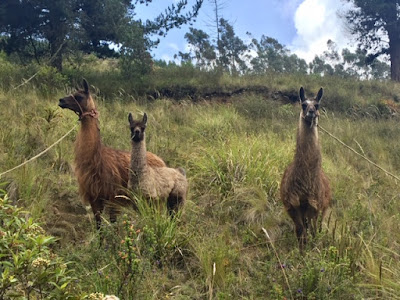 |
| Llamas provide wool, and a little character to the hillsides. |
So, after three days with Simon and Nieves in “el campo”, I was able to get a small glimpse into what one example of rural mountain life looks like in Ecuador. But is this “poverty”? To learn more, I turned to the Internet for a definition:
A 2016 ranking of the riches to poorest countries according to their GDP per capita, adjusted for relative purchasing power of the citizens, ranks Ecuador the 105th poorest out of 192 countries.
Poverty is about not having enough money to meet basic needs including food, clothing and shelter. However, poverty is much more than not having enough money.
Simon and Nieves have resources to meet their basic needs. They have a home. They have electricity and a water source that is being sterilized by the sun. They grow much of their own food for themselves and their animals, and they can sell the extra at a market. In Ecuador, each life-long subsistence farm family (when they reach retirement age) is given around $100 per month from the government. This is called an “agriculture pension”. Carmen also told me that her father, Simon, paid into a Social Security System his whole life in order to receive money back now that he is older. Therefore, they do have some money to buy other types of food and supplies. It is true, they do have to pay for electricity and taxes on their land, but because they are senior citizens, both of these bills are 50% of the normal price and are relatively minor. They also help provide funds for the community needs: to fix up the church, the community center, or help pay for community events.
They are also healthy. They breathe some of the cleanest air in the world, and walk up and down the mountain trails daily to reach their different fields. Therefore, their work and lifestyle makes them strong and robust. Because Ecuador has a universal health care system, they have access to doctors and medicine as they need. If they do get sick, they first try to use plant and animal-based natural remedies passed down through generations. When they do have to go to a doctor, their children take them to Quito. Medicine is not free, but it is subsidized for senior citizens and can be fairly inexpensive. Additionally, they also have a support system. They live in a tight-knit community where neighbors are constantly coming and going along the paths next to their house. And their children are watching out for them too. Finally, everyone else in their community is living at the same standard. So, according to the definitions of poverty, they aren’t necessarily poor.
But let’s look at what they don’t have. The lack of potable water is a precarious problem. As long as it rains, the reservoir is full, and the tubes carry the water to their house, they are fine. If something changes, then they would have to spend a lot of money repairing the problem, or buying bottled water and getting it up the mountain to their home. Also, when it rains too much, there is a lot of turbulence in the water, and the silt clogs their pipes. Then, they have to wait for the silt to settle out of the water before being able to use it again.
Living essentially in the dirt, cooking over an open fire and breathing in the smoke daily has probably not helped their health either. They could have a gas stove, but again, getting gas tanks up the hill could be a problem. Also, a fire provides ambient heat for their home, which a stove doesn’t do. Obviously obtaining wood is cheaper. It also makes it easier to burn the little garbage that they create.
| Happy Birthday, Simon! |
Education has also been limited, or non-existent for them both. Simon went to school until the 3rd or 4th grade and he knows how to read and write. Nieves went to school until the 4th grade, and used to know how to read and write, but hasn’t needed to use these skills for many years.
They also don’t have adequate transportation options. They rely on walking, riding their burro, paying for a taxi or hitching a ride to get them where they need to go. Furthermore, they don’t have a television, or access to news sources. And Simon broke his cell phone, so they don’t have an ability to communicate directly with his six children.
And finally, from everything I saw, they do lack a variety of foods and nutrition in their diet. The Ecuadorian diet in the Sierra Mountain region is heavy on protein and carbohydrates. Small amounts of vegetables are often only featured in the mid-day soup. Fruit is generally a luxury that probably has to be bought at a market and carried up the mountain.
So, are they poor? Yes. But not as poor as many people in the world.
Ecuador is a food rich country. And they have other resources such as health care, and a culture of supporting their own. They’re safe, seemingly happy and doing pretty well for their mid-80’s. When I was gathering information for this blog post, their children wanted to make sure I added how proud they are of their parents and grandparents, and proud of their family heritage coming from “el campo” – the countryside, the heartbeat of Ecuador.

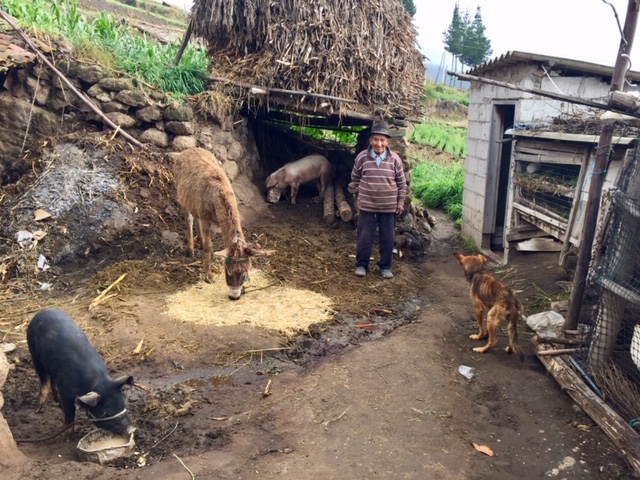









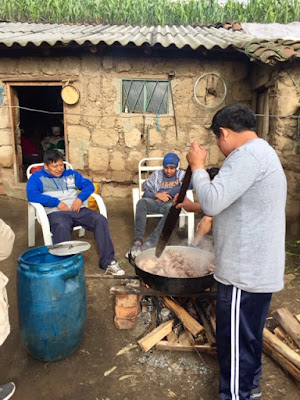



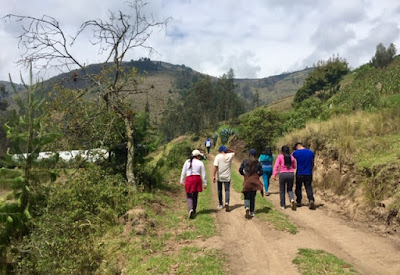






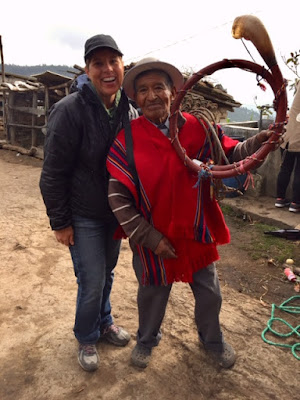
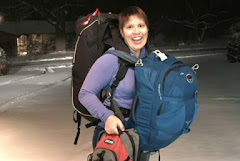
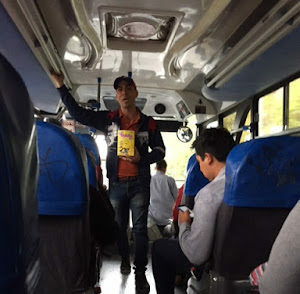

My Love Letter to Ecuador - On the Wing Adventures
[…] into the corner on the dirt floor of the kitchen. It was nice to see them both doing so well. Living in El Campo and Celebrating Carnaval in Bacun, Ecuador (2019) (Note: These posts from 2019 were by far my […]